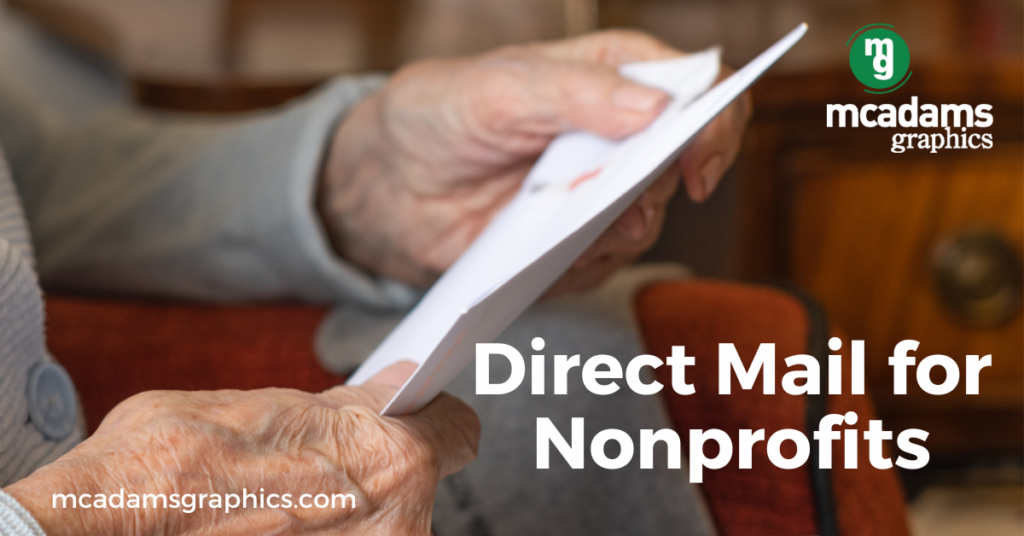
Direct Mail for Nonprofits: A Powerful Tool in the Digital Age
With more than 1.5 million nonprofits in the US, it can be challenging to stand out from others that may support a similar cause or have a similar mission.
But it’s not impossible!
Although marketing is increasingly digitized, direct mail has not gone the way of the dinosaur.
- It’s still relevant.
- It can increase a nonprofit’s reach in a tangible, measurable way.
- And it can increase a nonprofit’s pool of potential donors and supporters.
Let’s break down how you can effectively add this branch of marketing to your nonprofit’s strategy.
Direct Mail For Nonprofits: An Overview
Direct mail is a form of marketing communication where materials such as printed flyers, catalogs, letters, and postcards are sent directly to the homes or offices of targeted recipients.
Direct mail campaigns are designed to engage potential donors in a personal way, with customized messages and appeals that resonate with their interests, needs, and values.
7 Ways Nonprofits Use Direct Mail Campaigns
- Fundraising. This is the most common way that nonprofits use direct mail. Organizations distribute letters or pamphlets outlining their work and impact and request donations. This could be a broad fundraising appeal or a specific initiative.
- Thank You Letters. They show appreciation, strengthen relationships with donors and encourage future giving.
- Newsletters. Keep supporters updated on the organization’s work and increase engagement and connection to the organization’s mission.
- Event Invitations. Encourage supporters to attend events (fundraising and volunteer appreciation) and annual meetings. It creates a sense of personal connection, which can boost engagement.
- Informational Brochures. A helpful way to raise awareness, educate the public, and attract new supporters
- Membership Drives. Recruit new members or remind current members to renew their membership.
- Donor Surveys. Help your nonprofit improve its strategies and build stronger relationships with supporters.
To use direct mail, nonprofits should ensure they have a reliable database of recipient addresses, segment their audience for targeted messaging, craft compelling and personalized content, and track their results to improve their direct mail efforts continually.
Why Is Direct Mail So Effective For Nonprofits?
The direct mail approach can be particularly effective for nonprofit organizations for several reasons:
- Targeted Messaging: Reach the demographics most likely to support the cause. A nonprofit can use accurate data to segment its audience by income, age, location, or previous donation behavior.
- Tangibility and Personal Touch: A well-crafted mail piece can evoke emotion, tell a compelling story, and create a sense of personal connection to the cause.
- High Engagement: People often take the time to read their mail, which can result in higher engagement rates than digital marketing.
- Multi-Channel Integration: A direct mail piece can direct recipients to a specific landing page on a nonprofit’s website, promoting digital interaction and increasing overall engagement.
- Trackable Results: By using unique URLs, QR codes, or asking recipients to bring the mail piece to an event, it’s possible to track the effectiveness of direct mail campaigns, providing insights for future efforts.
- Donor Retention and Acquisition: A thank-you letter or an update on the impact of a donor’s past contribution can make donors feel valued and connected to the cause, increasing the likelihood they will donate again. Direct mail can spark interest and potentially lead to new donations.
Why Is Messaging So Important For Nonprofits?
The nonprofit sector’s primary goal is to support the specific cause that the organization has chosen. Since this sector is mainly funded through donations, they rely on messaging to express their goals, beliefs, and effect and create an emotional connection with potential donors.
Messaging shapes opinions, motivates action, builds trust, and distinguishes the organization from competitors. Nonprofits can advocate for their cause, collect funding, and engage their communities by using clear, engaging language.
How Nonprofits Can Leverage Direct Mail
Nonprofit campaigns can leverage direct mail effectively through several strategies:
- Tell a compelling story about the organization, beneficiaries, or the impact of donations which can help emotionally engage recipients and motivate them to support the cause.
- Personalize with the recipient’s name and, if possible, other details to make the message more relevant and engaging.
- Include a clear call to action. Whether the goal is for recipients to donate, attend an event, or sign up for a newsletter, tell them exactly what you’d like them to do.
- Combine direct mail with other marketing channels like email, social media, and the organization’s website. For example, use direct mail to drive traffic to the nonprofit’s website or social media profiles. Aim for a truly multi-channel marketing strategy to get the best ROI.
- Align direct mail campaigns with specific times of the year when people are more likely to donate, such as the holiday season or the end of the financial year.
- Test different approaches to direct mail, such as different messaging, designs, or calls to action, to see what works best. Use analytics to track results and continuously improve campaigns.
Why You Need A Professional Printing Company For Your Next Direct Mail Campaign
Finally, to leverage direct mail effectively, a nonprofit organization should work with a printing company that understands its specific needs. The company should offer services like data segmentation, personalized printing, and ROI tracking, as well as have a deep understanding of how to create compelling and persuasive mail pieces.
Inline printing (which is printing content on materials as they are being manufactured or processed) can also provide greater cost and time efficiency for nonprofit organizations. It can also enhance customization capabilities, as unique information can be printed on each piece during processing.
Partnering with a professional printing company can provide several benefits that can enhance the impact of future direct mail campaigns.
- Expertise and Experience: Printing companies specialize in creating compelling, high-quality direct mail pieces. They understand what works and what doesn’t, from design and layout to messaging and calls to action. They can guide on best practices and help avoid common pitfalls.
- High-Quality Production: A professional printer will ensure that direct mail pieces are printed to a high standard, with clear images and text, consistent colors, and a professional finish. This can enhance the perceived value of the organization and its message.
- Personalization and Customization: Modern printing technologies allow for high levels of personalization and customization. A printing partner can personalize each mail piece with the recipient’s name, donation history, or other relevant information, making direct mail more engaging and relevant.
- Cost Savings: Printing companies often offer bulk discounts, and they can help optimize design and materials to save on postage costs. They can advise on cost-effective strategies like postcard campaigns or self-mailers that don’t require envelopes.
- Time Savings: By managing the printing and mailing process, a printing partner can save a nonprofit significant time, allowing more focus on the core mission.
- Data Management: Many printing companies can help with data management, ensuring that mailing lists are up-to-date and accurately targeted. They can also help with tracking and analytics so success is measured.
By selecting the right printing partner, you can ensure that your direct mail campaign is professionally executed, effectively targeted, and delivers the best possible return on investment for your nonprofit organization.
McAdams Graphics has provided direct mail printing and mailing services for over 35 years. Click here to contact our team and talk about your next direct mail campaign.

